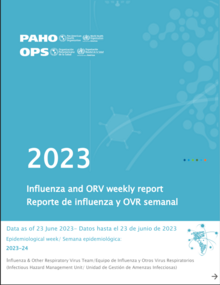North America: Influenza activity has remained at low levels. During the last 4 epidemiological weeks (EW), the predominant influenza viruses have been B/Victoria, with a lesser circulation of influenza A (mostly A(H1N1)pdm09). Respiratory syncytial virus (RSV) activity has remained low. The activity of SARS-CoV-2 has decreased, although it continues to circulate at moderate levels. Cases of influenza-like illness (ILI) and severe acute respiratory infection (SARI) have shown a decreasing trend, with the majority of these cases associated with SARS-CoV-2 and to a lesser extent influenza.
Caribbean: Influenza activity has shown a decreasing trend. During the last 4 epidemiological weeks, the predominant influenza viruses have been B/Victoria, with lesser circulation of influenza A (mainly A(H1N1)pdm09). RSV activity has remained low. SARSCoV- 2 activity has increased in the last 4 weeks and is currently at intermediate levels of circulation. Cases of ILI and SARI have shown an increase due to positive SARS-CoV-2 cases and to a lesser extent influenza cases.
Central America: Influenza activity has shown a pronounced increase in the last 4 EW with high levels of circulation. During the last 4 epidemiological weeks, the predominant influenza viruses have been influenza A, mainly A(H1N1)pdm09, with concurrent circulation of influenza A(H3N2) and influenza B/Victoria to a lesser extent. RSV activity has remained low. SARS-CoV-2 activity has remained low and has decreased in recent weeks. The incidence of ILI cases has remained low, while there has been an increase in SARI cases, predominantly linked to influenza. In Costa Rica, extraordinary levels of influenza positivity have been observed. However, the occurrences of ILI and SARI have remained low, with the majority of cases attributed to influenza. Honduras has experienced high-extraordinary levels of influenza positivity in recent weeks, accompanied by a declining trend in activity and moderate SARI case numbers, all of which can be attributed to influenza. Nicaragua and Panama have also witnessed an upturn in influenza positivity, characterized by moderate levels of intensity in both countries.
Andean region: Influenza activity remains stable at low levels. During the last 4 EW, the predominant influenza viruses have been influenza A, mostly A(H1N1)pdm09, with lesser circulation of influenza B/Victoria. RSV activity has shown a decrease, remaining at moderate levels of circulation. SARS-CoV-2 has shown an increase, circulating at moderate levels. The incidence of SARI cases has exhibited a slight rise, primarily attributed to influenza cases, with lesser contributions from RSV and SARS-CoV-2. ILI activity has shown a decreasing trend, with the majority of cases associated with influenza.
Brazil and Southern Cone: Influenza activity has decreased to moderate levels of circulation. During the last 4 EWs, the predominant influenza viruses have been mainly A(H1N1)pdm09, with simultaneous circulation of influenza B/Victoria virus. RSV activity has decreased in the last two EWs, reaching moderate levels. SARS-CoV-2 activity has remained low. After reaching a peak, both SARI and ILI activity have decreased in the last 4 EWs, with the majority of cases testing positive for RSV and influenza. In Chile, extraordinary levels of ILI activity have been observed, with the majority of cases linked to RSV and influenza. This activity has shown a decline in recent weeks, but remains at high levels. Moderate levels of SARI activity have also been detected in Chile, with RSV being the most common cause among positive cases. This activity has also experienced a decrease in the past week and is currently at epidemic levels. In Paraguay, an extraordinary level of SARI activity has been observed, with RSV being the primary cause among positive cases, followed by influenza and, to a lesser extent, SARS-CoV-2. In Uruguay, there has been an increase in SARI activity, reaching low-to-moderate levels levels, with the majority of cases associated with RSV, followed by influenza.
|

